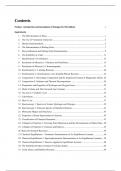Exam (elaborations)
Instructor Resource Manual for Chemistry 10th Edition by Steven S. Zumdahl, Susan A. Zumdahl , Donald J. DeCoste
- Course
- Institution
- Book
Instructor Resource Manual for Chemistry 10th Edition by Steven S. Zumdahl, Susan A. Zumdahl , Donald J. DeCoste
[Show more]



